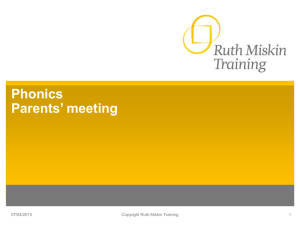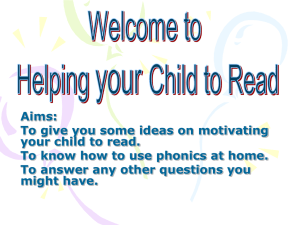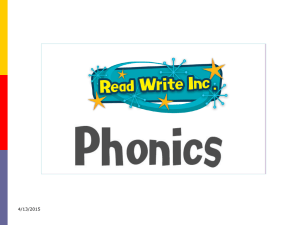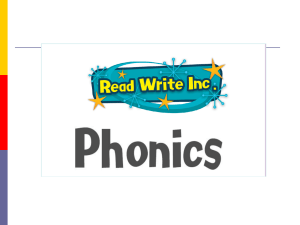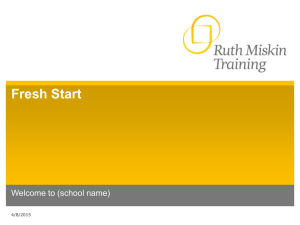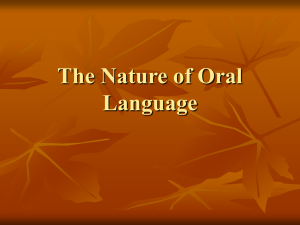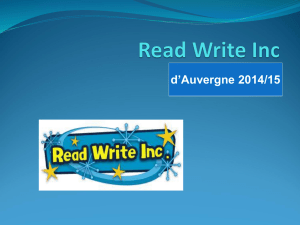Phonics Workshop Powerpoint – Nov 2013
advertisement
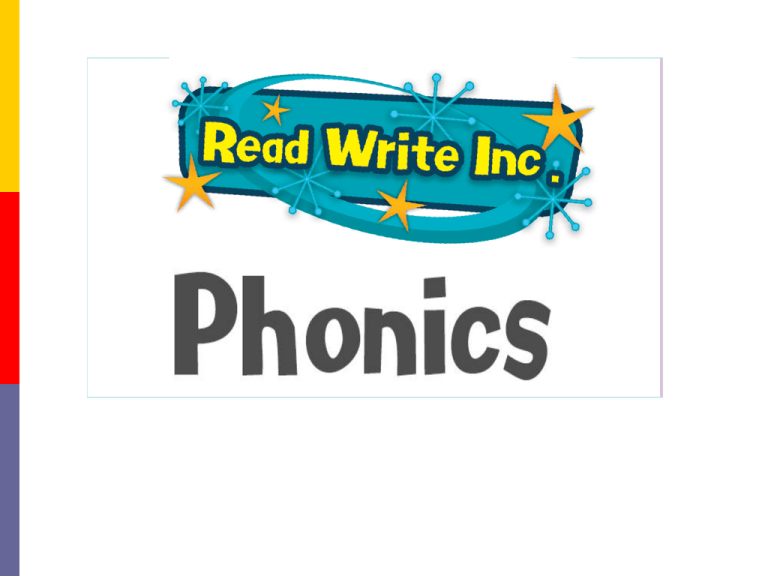
Why synthetic phonics? “Synthetic phonics offers the vast majority of young children the best and most direct route to becoming skilled readers and writers” Sir Jim Rose Rose Review of Reading 2006 Synthetic phonics is the ability to convert a letter or letter group into sounds that are then blended together into a word. Why Read Write Inc Phonics? Tried and tested over many years Systematic and structured Early success in reading Training and ongoing staff development What is Read Write Inc Phonics? A rapid Learn to read programme so children can… Read to learn for the rest of their lives Who is it for? 4 year olds plus Older children who need to ‘catch-up’ Children new to English How does it work? Children: Learn 44 sounds and matching letters/letter groups Learn to blend sounds to read words Read lots of specially written books This is decoding How does it work? Children: Talk a lot about what they have read to show they understand Listen to and discuss other ideas to deepen understanding This is comprehending We do lots of talking in partners Sounds All words are made up of sounds In English there are 44 Graphemes A grapheme is a sound written down English has more than 150 graphemes There are more than 150 ways to represent the 44 sounds using our 26 alphabet letters A complex code! Chart This chart shows the most usual graphemes for the 44 sounds The complex English alphabetic code Learning the code Children learn a simple code first If English had a simple code spelling and reading would be much easier!! play mayk trayn cafay strayt wayt brayk green dreem kee hee happee light kight fligh Igh igh tigh blow smowk flowt gow mowst moon broot bloo groo c-a-t ch-a-t l-igh-t c-r-a-sh Fred... Fred helps children learn to read Fred can only talk in sounds... (Fred can only say c_a_t, he can’t say cat) We call this Fred Talk Fred... If children understand Fred they can blend orally Blending is needed for reading Fred... Fred helps children learn to spell as well! Children convert words into sounds They press the sounds they hear on to their fingers... We call this Fred Fingers Consonants: stretchy f l m n r s v z sh th ng nk Consonants: bouncy b c k d g h j p qu t Vowels: bouncy a e oo oo w x y ch igh ow Vowels: stretchy i Set 1 sounds o ar u or ay air ee ir ou oy Set 2 sounds f l m n r s v z sh ff ph ll le mm mb nn kn rr wr ss se c ce ve zz s ti ci b c k d g bb ck ch dd gg a e h i j p g ge dge pp o u ea oo u_e ue ew oo ar qu t w tt wh th x ng nk y ch tch ay ee igh ow a_e ai y ea e i_e ie i o_e oa o or air ir ou oy oor ore aw au are ur er ow oi ire ear ure Nonsense words These words are made up They ensure that all children understand the sounds and don’t just memorise words We assess children on real words and nonsense words to ensure that they have a full understanding Assessment We assess children reading every day informally through hearing them read with their partner As RWI manager I assess each child to be able to group them The children also have a phonics screening check in Year one Phonics Screening check This takes place once a year for Year one children in June The children are tested on their set 1, 2 and 3 sounds with real words and nonsense The pass mark is high – 32 out of 40 If your child scores less than 32 they will re take the check in the June of Year 2. Storybooks and Get Writing Books Film of RWI in action! So how can you help your child? By knowing the 44 sounds By knowing how to blend using Fred Talk for reading m_a_t And... By having fun with Fred Talk at home! “What a tidy r-oo-m!” “Where’s your c-oa-t?” “Time for b-e-d!” back, head, tum, leg, hand, foot, knee coat, hat, scarf, zip, sock, glove run, walk, skip, hop, fast, slow, stop, shop red, blue, green, black, knife, fork, spoon, plate, bowl, pan bread, cheese, meat, soup, jam, cake And... By reading to your child lots of lovely stories and asking lots of questions! Use these prompts to help you: What do you think happens next? What is that character thinking? What is happening? What is the character saying? What do you think that character is feeling now? And... By talking to your child as much as possible and ‘feeding’ them new and different words: “Let’s “Let’s “Let’s “Let’s eat our lunch now.” munch our lunch now.” scoff our lunch now.” devour our lunch now!” You’re looking ...not just...but... I’m not just... I’m....! And... By enriching conversations through description: “Look at that rain. It looks like little diamonds sparkling on the window pane!” By having fun with words and language. “I’m as hot as a spud in a cooking pot!” By praising your child for using new words or interesting images And... By having a look at the parents’ pages on the web for tips and resources for supporting your child at home: www.ruthmiskinliteracy.com Type into google Ruth Miskin Phoneme pronunciation guide to watch a clip about how to pronounce the sounds or follow the link below: https://global.oup.com/education/content/primary/tea ching-support/pages/rwi/?region=uk# Thank you... Happy reading!
